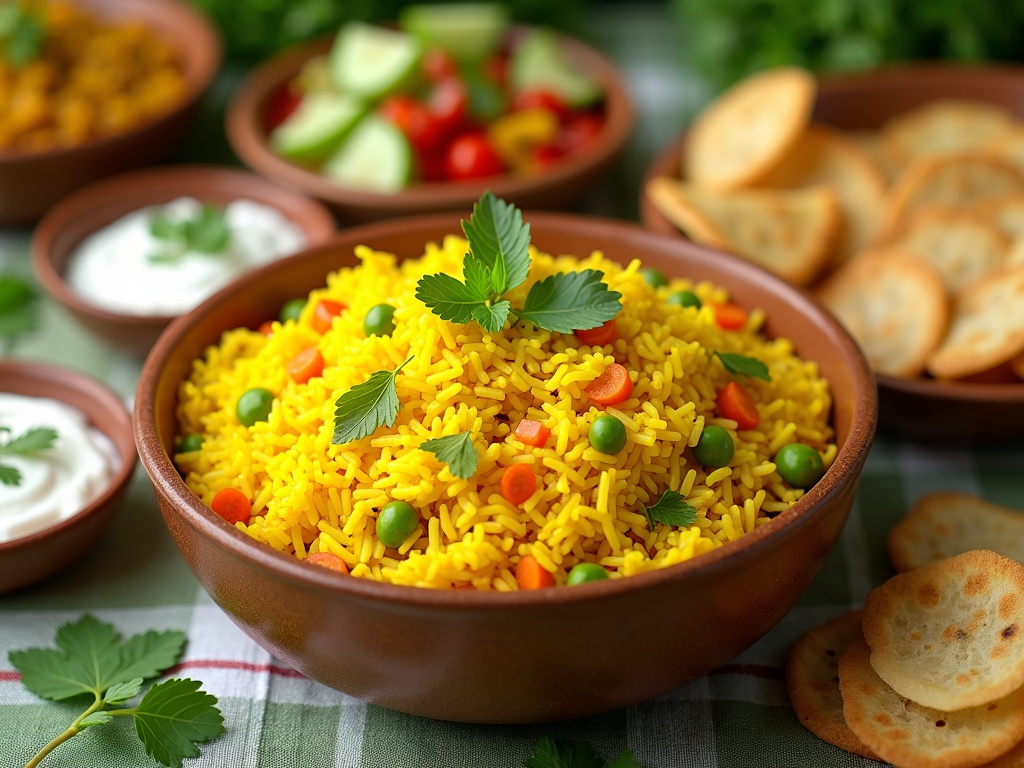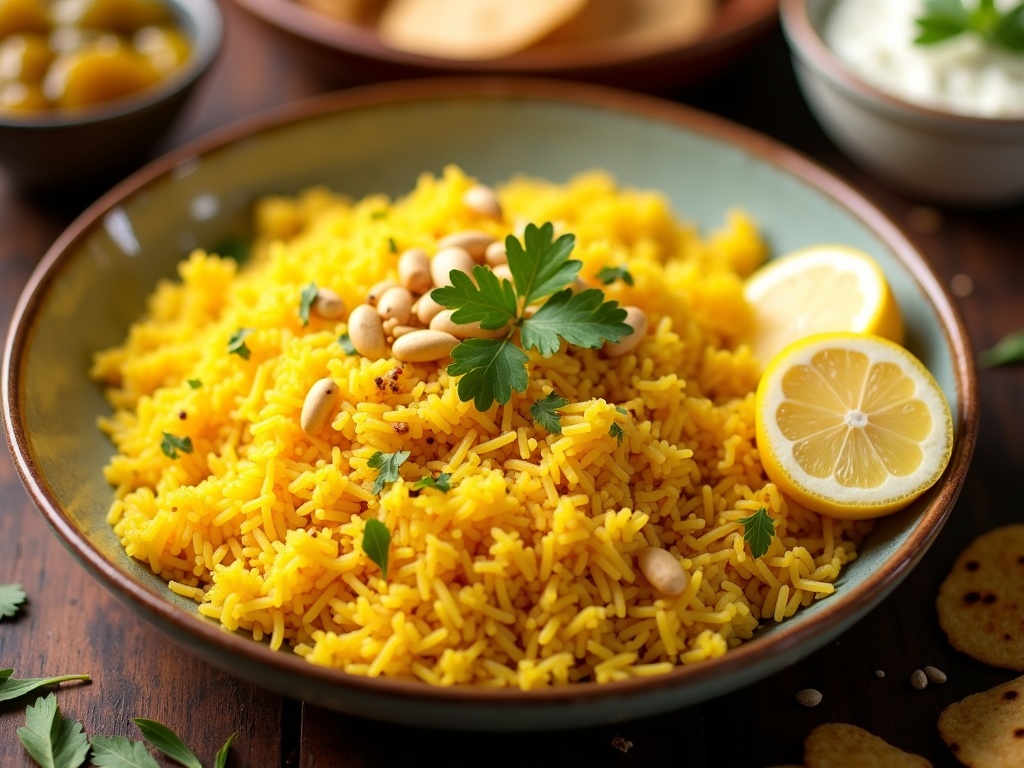Lemon rice recipe, a vibrant South Indian dish combining basmati rice with zesty lemon juice, turmeric, and aromatic spices, creates a perfect balance of tangy and savory flavors. This versatile recipe transforms simple ingredients into a golden-hued culinary delight that can be enjoyed as a standalone meal, packed for lunch, or served alongside traditional accompaniments like raita and pickles.
Find In This Article
Key Takeaways
- The dish requires simple ingredients including cooked rice, fresh lemon juice, turmeric powder, mustard seeds, curry leaves, and optional peanuts or cashews for added crunch.
- Day-old or completely cooled rice works best for maintaining proper texture and preventing mushiness when mixing with other ingredients.
- The tempering (tadka) process with mustard seeds, urad dal, and curry leaves is essential for developing authentic South Indian flavor.
- Lemon rice keeps well for up to 3 days in the refrigerator and often tastes better the next day as flavors continue to develop.
- Each cup provides approximately 250 calories with a balanced mix of carbohydrates, protein, and healthy fats, making it a nutritious meal option.
Why Lemon Rice Recipe is a South Indian Favorite
Lemon rice stands out as a quintessential South Indian dish that captures hearts with its vibrant yellow color and zesty flavor profile. I’ve found this simple yet delicious recipe becomes an instant favorite for anyone trying South Indian cuisine for the first time. The dish gets its signature sunshine hue from turmeric powder, which pairs perfectly with the refreshing citrus punch from freshly squeezed lemon juice.
Health Benefits and Versatility
The combination of ingredients in lemon rice offers more than just flavor. Turmeric, a key component, contains curcumin which provides notable anti-inflammatory properties. This makes lemon rice not only delicious but also beneficial for your overall health. The dish’s versatility allows it to be served in multiple ways:
- As a standalone main dish for a quick lunch
- Alongside vegetable curries for a complete meal
- Packed in lunchboxes as it tastes great even when cold
- As part of thali platters featuring multiple dishes
- Served with yogurt raita for a cooling contrast
In South Indian households, lemon rice holds special cultural significance during festivals and celebrations. It’s often prepared during important occasions like Pongal and family gatherings, where its bright color symbolizes prosperity and happiness. Many families consider it an auspicious dish, making it a staple offering during religious ceremonies and community feasts.
What makes this dish particularly appealing is its simplicity in preparation combined with complex flavors. The tempering of mustard seeds, curry leaves, and peanuts creates a delightful crunch that contrasts with the soft texture of the rice. If you’re looking to expand your repertoire of rice dishes, lemon rice offers an excellent starting point for exploring South Indian flavors.
The dish’s popularity extends beyond South India, with variations found across different regions, each adding their unique twist while maintaining the essential tangy lemon character that makes this dish so beloved.
Essential Ingredients for Perfect Lemon Rice Recipe
I’ve discovered that making perfect lemon rice requires specific ingredients that work together to create that signature tangy flavor and beautiful yellow color. Let me share what you’ll need to prepare this classic South Indian dish.
Core Ingredients
The foundation of good lemon rice starts with 2 cups of cooked rice. I prefer using basmati or sona masuri varieties for their texture and aroma. Day-old rice actually works best as it’s firmer and less likely to become mushy when mixed with other ingredients.
The star ingredient is 1 medium lemon, which should yield enough juice to infuse the entire dish with its bright, citrusy flavor. Turmeric powder (1/2 teaspoon) adds that gorgeous yellow color while contributing subtle earthy notes.
For the cooking fat, 2 tablespoons of vegetable or mustard oil works perfectly. The oil carries the flavors throughout the rice and helps in tempering the spices properly.
Tempering Spices and Aromatics
The tempering (or tadka) is what elevates lemon rice to another level. Here are the key components:
- 1/2 teaspoon mustard seeds provides a nutty, slightly spicy pop
- 1 teaspoon urad dal adds a subtle crunch and nutty flavor
- 2-3 slit green chilies contribute heat that balances the tanginess
- 10-12 curry leaves infuse an incredible aroma that’s essential for authentic flavor
- Salt to taste harmonizes all the ingredients
I always finish my lemon rice with a generous sprinkle of fresh coriander leaves for garnish. This adds a pop of color and fresh herbal notes that complement the tangy lemon beautifully.
The beauty of lemon rice lies in its simplicity – these basic ingredients transform plain rice into a vibrant, flavorful dish that works as a main course or side dish. For a complete meal, I sometimes add roasted peanuts or cashews for extra crunch and protein.
When all these ingredients come together, they create a delightful balance of tangy, spicy, and aromatic flavors that make lemon rice a beloved favorite in South Indian cuisine. Each component plays an important role, so I don’t recommend skipping any of them if you want to achieve that authentic taste.
Step-by-Step Cooking Method
Creating perfect lemon rice is all about timing and technique. I’ve broken down this straightforward process into manageable steps that ensure your rice turns out flavorful and aromatic every time.
Preparing the Tempering
First, I heat 2 tablespoons of oil in a large pan over medium heat. Once the oil is hot, I add mustard seeds and wait for them to pop—this usually takes about 30 seconds and creates a wonderful nutty aroma that forms the foundation of lemon rice.
Next, I add urad dal (split black gram), dried red chilies, and curry leaves to the popping mustard seeds. This combination needs to sauté for just 30 seconds—any longer and the dal might burn, creating a bitter taste. The curry leaves will become crisp, releasing their distinctive fragrance throughout the dish.
I then sprinkle in turmeric powder, stirring quickly to ensure it coats the ingredients evenly. The vibrant yellow color begins to develop, giving lemon rice its characteristic golden hue.
Combining Rice and Seasonings
With the tempering ready, I gently fold in the cooked rice. It’s important to use rice that’s completely cooled to prevent it from becoming mushy. I add salt according to taste and mix carefully, ensuring each grain gets coated with the spiced oil mixture.
The final essential ingredient is fresh lemon juice, which I pour over the rice and mix thoroughly. The amount depends on how tangy you prefer your dish—I typically use juice from one large lemon for every two cups of cooked rice.
For the finishing touch, I sprinkle freshly chopped coriander leaves over the top. This adds a pop of color and freshness that complements the tanginess of the lemon perfectly.
Several key points contribute to making exceptional lemon rice:
- Use day-old or completely cooled rice for best texture
- Don’t skip the tempering sequence—it’s crucial for developing authentic flavor
- Adjust lemon juice gradually according to personal preference
- Fold the rice gently to maintain grain integrity
This versatile dish pairs beautifully with raita, pickle, or simply enjoyed on its own. If you’re looking for more rice variations, you might want to check out my lemon rice collection for different regional adaptations of this classic recipe.
Smart Storage and Serving Ideas
Lemon rice tastes even better the next day as the flavors have time to meld together. I’ve found this classic South Indian dish to be incredibly versatile when it comes to storage and serving options, making it perfect for meal prep and gatherings alike.
Storage Tips for Maximum Freshness
Lemon rice keeps beautifully in the refrigerator for up to 3 days when stored in an airtight container. The key is to let it cool completely before transferring it to your storage container to prevent condensation, which can make the rice soggy. When you’re ready to enjoy it again, a simple trick is to reheat it with a small splash of water. This helps restore moisture that might have been lost during refrigeration, bringing back the rice’s original texture.
The flavor of lemon rice actually intensifies after spending a day in the refrigerator. The lemon juice, turmeric, and spices continue to infuse the rice, creating an even more aromatic and flavorful dish when you reheat it. This makes it an excellent make-ahead option for busy weekdays.
Serving Suggestions and Variations
Lemon rice is traditionally served hot with accompaniments that complement its tangy flavor profile. Try serving it with:
- A spicy pickle that contrasts nicely with the citrusy notes
- A cooling yogurt or raita to balance the spices
- A simple cucumber salad for freshness
- Crispy papads for added texture
I’ve packed lemon rice countless times for lunch boxes and picnics because it travels exceptionally well and tastes great at room temperature. Unlike many dishes that need to be piping hot to be enjoyable, lemon rice maintains its appeal even after sitting for a few hours, making it perfect for outdoor meals.
For added nutrition and color, consider mixing in vegetables like peas, carrots, or bell peppers. These additions not only boost the nutritional profile but also create a complete one-pot meal. When making lemon rice with vegetables, I usually steam them separately and mix them in just before serving to maintain their vibrant colors and nutrients.
Children particularly enjoy this dish when it’s made slightly less spicy and with colorful vegetables mixed in. The bright yellow color from the turmeric combined with the fresh vegetables makes it visually appealing, and the tangy lemon flavor is generally a hit with younger palates.
For a more substantial meal, pair lemon rice with a simple dal or a vegetable curry. The simple, clean flavors of the rice provide an excellent base for more complex curries, creating a balanced meal that’s satisfying without being heavy.
During summer months, I like to add a handful of fresh herbs like cilantro or mint just before serving to brighten the dish even further. The herbs add a fresh dimension that complements the lemon flavor perfectly.

Nutritional Benefits Per Cup
Lemon rice is more than just a flavorful dish – it’s packed with essential nutrients that make it a balanced meal option. Each cup of this tangy rice preparation provides a good mix of macronutrients while keeping the calorie count reasonable.
Macronutrient Breakdown
A single cup of lemon rice contains approximately 250 calories, making it a moderate calorie option that fits well into most meal plans. It offers 4g of protein, which helps with muscle maintenance and repair. The dish provides 35g of carbohydrates, making it an excellent energy source for your daily activities. With 10g of fat, it delivers essential fatty acids while the 3g of fiber promotes digestive health and helps maintain satiety.
Health Benefits
I’ve found lemon rice to be particularly beneficial as a pre-workout meal due to its carbohydrate content, which provides sustained energy throughout exercise sessions. The combination of rice with lemon adds a refreshing twist while delivering vitamin C, an antioxidant that supports immune function.
This dish serves as a fantastic vegetarian-friendly option that can easily be incorporated into various dietary patterns. Its balanced nutritional profile makes it suitable as a standalone meal or as a side dish complementing protein-rich foods like beans or tofu.
For those looking to enhance the protein content, I’d suggest adding a handful of roasted peanuts or cashews, which pairs beautifully with the tangy lemon flavor. The versatility of lemon rice allows for endless customization while maintaining its core nutritional benefits.
Whether you’re focused on maintaining energy levels throughout the day or simply want a tasty yet nutritious meal option, lemon rice delivers on both fronts without requiring complicated preparation or hard-to-find ingredients.
Sources:
Traditional Indian Recipes by Indian Cuisine Society
Health Benefits of Turmeric by Wellness Journal
The History of South Indian Food by Culinary Heritage Journal

